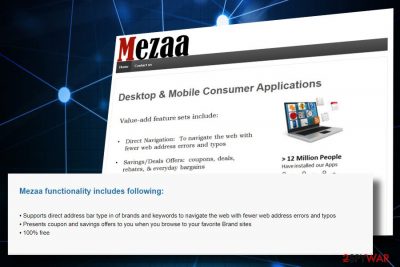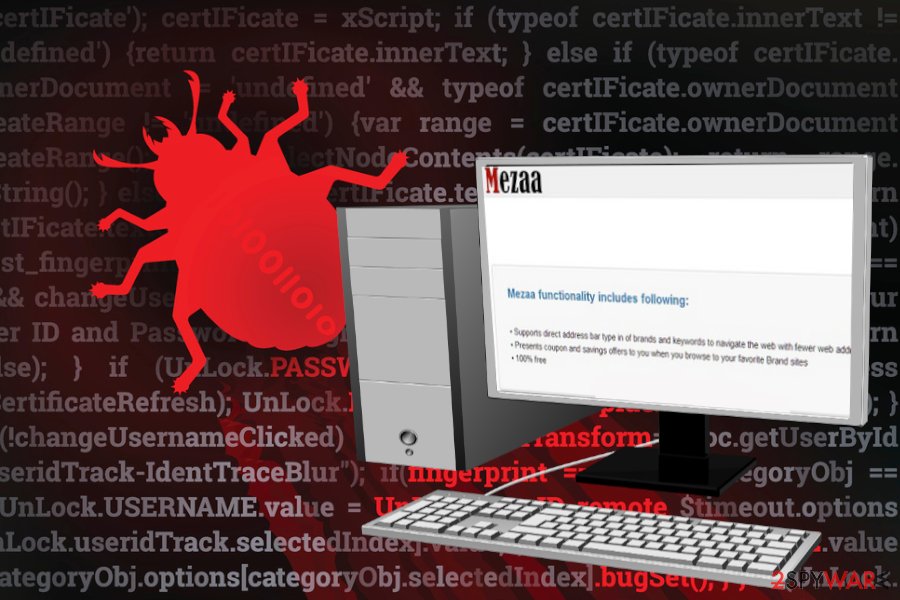Mezaa virus (Free Instructions) - updated Jun 2021
Mezaa virus Removal Guide
What is Mezaa virus?
Mezaa is a questionable adware-type program that exposes users to dangerous contet

Mezaa is a potentially unwanted application that usually gets installed together with freeware and shareware, so users are unaware of its infiltration. The app is one of the most aggressive adware,[1] as it modifies registry entries and creates subkeys on the Windows operating system to perform its activities. Adware is known to deliver pop-up ads and in-text links into legitimate sites (such as Amazon) on Google Chrome and other browsers and also installing additional suspicious applications on the targeted computer without the user's consent. Due to such aggressive behavior, many AV vendors recognize the application as malicious under such names as Suspicious_GEN.F47V1109, Artemis!FB9ED40BCDC8, Adware.Mezaa, MSIL/Adware.Sendori.A, etc.
| Name | Mezaa virus |
|---|---|
| Classified as | Adware, PUA |
| AV detection | Suspicious_GEN.F47V1109, Artemis!FB9ED40BCDC8, Artemis, Mezaa, Adware.Mezaa, MSIL/Adware.Sendori.A |
| Related files | MZA.exe, MezaaSvc.exe, Mezaa.Service.exe |
| Danger level | Medium due to heavy Windows Registry modification |
| Symptoms | An excessive amount of commercial ads |
| Distribution | Freeware bundling |
| Elimination | You should rely on anti-malware tools and clean the machine fully. The guide below should also help when dealing with intruders like this |
| FortectIntego is a reliable security tool that can eliminate related apps and virus damage with one click. | |
Mezaa virus was active since late September 2014, and the application (that allegedly helps users with their shopping) was available on the rather poorly executed website. However, as of 2018, the official site has been removed and the only way users still obtain the adware is by installing it as an optional component bundled with other software.[2]
Once installed, Mezza changes the Windows startup system and starts running MZA.exe, MezaaSvc.exe, and Mezaa.Service.exe processes within Task Manager. They are responsible for the execution of the adware, as well as injection of a related extension to the default web browser, be it Chrome, Firefox, Edge, or Safari. The app then modifies Windows Registry, making the virus removal a much harder task than it would normally be, comparing it with regular adware apps.
First of all, the web browser's load time may be prolonged, so you may be forced to wait for the startup window to open for a minute or two. However, the most prominent sign of the virus presence is a continuous attack of ads. Pop-ups, banners, interstitial ads, in-text links, full-page auto-play ads, etc. may flood your screen and prevent you from viewing the content that matters for you.
Usually, intrusive ads contain various offers that are available on its partners' web stores. However, some of the pop-ups may be powered by suspicious third parties that may try to foist useless services or trick people into downloading malware. Therefore, if you see ads claiming that your system is infected with a virus or that you have been selected to win valuable prizes, do not fall for clicking on them. Such and similar ads may be a catch leading to phishing or scam[3] websites.
In addition to intrusive ads, Mezaa virus aims at collecting users' Search Data. It includes
- IP address
- Email address
- Search queries
- Most visited websites
- Bookmarks, and similar browsing-related information.
Even though it's not considered as personally identifiable (PI), its disclosure to third parties is not recommended. That's because the number of ads may grow even more. Besides, they may be improved according to your preferences, thus have more potential to be clicked on.

Anyway, we encourage you to remove Mezaa from the system. This way, you will clean the system from malware, as well as delete intrusive content from your web browser. The easiest way to get rid of unwanted programs is to run a full scan with a professional anti-virus. Nevertheless, you can perform the removal manually with the help of a guide given at the end of this article.
Finally, we recommend scanning your device with SpyHunter 5Combo Cleaner, Malwarebytes, or a similar PC repair tool after the PUP removal. The mentioned software can remove Registry entries created by PUP and make sure that no “Ads by Mezaa” will show up on your browser again.
Adware can unravel its ads with the help of freeware
Not all, but many adware-type programs can be downloaded from official websites or sometimes from such reliable sources as Google Play Store. In some of the cases, like in this one, adware has an official website, which does not provide a download button. That's a clear sign that the app you are looking at is a PUP, which is being distributed along with freeware.
Such unwanted tools are usually hidden under Quick or Basic installation options and marked by default. Consequently, if the PC's owner selects one of these options, he or she unconsciously permits to the installation of the whole software package.
To prevent the unexpected appearance of such apps, be very careful when installing freeware and shareware on your PC. The easiest way to disclose the bundle and reveal additional downloads is to choose Custom or Advanced installation option. Do not click the Next button for trying to speed up installation because you may easily miss the check mark that allows installation of PUPs.

Mezaa virus removal guide
If you noticed that your Internet browsing is frequently interrupted by ads that are labeled “brought to you by Mezaa,” “Mezaa ads,” and similar slogans, there's no doubt that adware programs infiltrated your PC via freeware bundle.
Your web browser will remain contaminated by intrusive advertisements as long as you won't remove malware from the system. You can do that in two ways, i.e., by scanning the system with a professional anti-virus or performing the system's check manually.
Mezaa removal is not a difficult task. However, the utanvirus.se[4] team claims that the automatic elimination process could save your day. Such and similar malware can find helper objects, which, if left intact, can reinstall adware and rebuilt third-party advertising servers.
You may remove virus damage with a help of FortectIntego. SpyHunter 5Combo Cleaner and Malwarebytes are recommended to detect potentially unwanted programs and viruses with all their files and registry entries that are related to them.
Getting rid of Mezaa virus. Follow these steps
Uninstall from Windows
Instructions for Windows 10/8 machines:
- Enter Control Panel into Windows search box and hit Enter or click on the search result.
- Under Programs, select Uninstall a program.

- From the list, find the entry of the suspicious program.
- Right-click on the application and select Uninstall.
- If User Account Control shows up, click Yes.
- Wait till uninstallation process is complete and click OK.

If you are Windows 7/XP user, proceed with the following instructions:
- Click on Windows Start > Control Panel located on the right pane (if you are Windows XP user, click on Add/Remove Programs).
- In Control Panel, select Programs > Uninstall a program.

- Pick the unwanted application by clicking on it once.
- At the top, click Uninstall/Change.
- In the confirmation prompt, pick Yes.
- Click OK once the removal process is finished.
Delete from macOS
Remove items from Applications folder:
- From the menu bar, select Go > Applications.
- In the Applications folder, look for all related entries.
- Click on the app and drag it to Trash (or right-click and pick Move to Trash)

To fully remove an unwanted app, you need to access Application Support, LaunchAgents, and LaunchDaemons folders and delete relevant files:
- Select Go > Go to Folder.
- Enter /Library/Application Support and click Go or press Enter.
- In the Application Support folder, look for any dubious entries and then delete them.
- Now enter /Library/LaunchAgents and /Library/LaunchDaemons folders the same way and terminate all the related .plist files.

Remove from Microsoft Edge
Delete unwanted extensions from MS Edge:
- Select Menu (three horizontal dots at the top-right of the browser window) and pick Extensions.
- From the list, pick the extension and click on the Gear icon.
- Click on Uninstall at the bottom.

Clear cookies and other browser data:
- Click on the Menu (three horizontal dots at the top-right of the browser window) and select Privacy & security.
- Under Clear browsing data, pick Choose what to clear.
- Select everything (apart from passwords, although you might want to include Media licenses as well, if applicable) and click on Clear.

Restore new tab and homepage settings:
- Click the menu icon and choose Settings.
- Then find On startup section.
- Click Disable if you found any suspicious domain.
Reset MS Edge if the above steps did not work:
- Press on Ctrl + Shift + Esc to open Task Manager.
- Click on More details arrow at the bottom of the window.
- Select Details tab.
- Now scroll down and locate every entry with Microsoft Edge name in it. Right-click on each of them and select End Task to stop MS Edge from running.

If this solution failed to help you, you need to use an advanced Edge reset method. Note that you need to backup your data before proceeding.
- Find the following folder on your computer: C:\\Users\\%username%\\AppData\\Local\\Packages\\Microsoft.MicrosoftEdge_8wekyb3d8bbwe.
- Press Ctrl + A on your keyboard to select all folders.
- Right-click on them and pick Delete

- Now right-click on the Start button and pick Windows PowerShell (Admin).
- When the new window opens, copy and paste the following command, and then press Enter:
Get-AppXPackage -AllUsers -Name Microsoft.MicrosoftEdge | Foreach {Add-AppxPackage -DisableDevelopmentMode -Register “$($_.InstallLocation)\\AppXManifest.xml” -Verbose

Instructions for Chromium-based Edge
Delete extensions from MS Edge (Chromium):
- Open Edge and click select Settings > Extensions.
- Delete unwanted extensions by clicking Remove.

Clear cache and site data:
- Click on Menu and go to Settings.
- Select Privacy, search and services.
- Under Clear browsing data, pick Choose what to clear.
- Under Time range, pick All time.
- Select Clear now.

Reset Chromium-based MS Edge:
- Click on Menu and select Settings.
- On the left side, pick Reset settings.
- Select Restore settings to their default values.
- Confirm with Reset.

Remove from Mozilla Firefox (FF)
Remove dangerous extensions:
- Open Mozilla Firefox browser and click on the Menu (three horizontal lines at the top-right of the window).
- Select Add-ons.
- In here, select unwanted plugin and click Remove.

Reset the homepage:
- Click three horizontal lines at the top right corner to open the menu.
- Choose Options.
- Under Home options, enter your preferred site that will open every time you newly open the Mozilla Firefox.
Clear cookies and site data:
- Click Menu and pick Settings.
- Go to Privacy & Security section.
- Scroll down to locate Cookies and Site Data.
- Click on Clear Data…
- Select Cookies and Site Data, as well as Cached Web Content and press Clear.

Reset Mozilla Firefox
If clearing the browser as explained above did not help, reset Mozilla Firefox:
- Open Mozilla Firefox browser and click the Menu.
- Go to Help and then choose Troubleshooting Information.

- Under Give Firefox a tune up section, click on Refresh Firefox…
- Once the pop-up shows up, confirm the action by pressing on Refresh Firefox.

Remove from Google Chrome
Delete malicious extensions from Google Chrome:
- Open Google Chrome, click on the Menu (three vertical dots at the top-right corner) and select More tools > Extensions.
- In the newly opened window, you will see all the installed extensions. Uninstall all the suspicious plugins that might be related to the unwanted program by clicking Remove.

Clear cache and web data from Chrome:
- Click on Menu and pick Settings.
- Under Privacy and security, select Clear browsing data.
- Select Browsing history, Cookies and other site data, as well as Cached images and files.
- Click Clear data.

Change your homepage:
- Click menu and choose Settings.
- Look for a suspicious site in the On startup section.
- Click on Open a specific or set of pages and click on three dots to find the Remove option.
Reset Google Chrome:
If the previous methods did not help you, reset Google Chrome to eliminate all the unwanted components:
- Click on Menu and select Settings.
- In the Settings, scroll down and click Advanced.
- Scroll down and locate Reset and clean up section.
- Now click Restore settings to their original defaults.
- Confirm with Reset settings.

Delete from Safari
Remove unwanted extensions from Safari:
- Click Safari > Preferences…
- In the new window, pick Extensions.
- Select the unwanted extension and select Uninstall.

Clear cookies and other website data from Safari:
- Click Safari > Clear History…
- From the drop-down menu under Clear, pick all history.
- Confirm with Clear History.

Reset Safari if the above-mentioned steps did not help you:
- Click Safari > Preferences…
- Go to Advanced tab.
- Tick the Show Develop menu in menu bar.
- From the menu bar, click Develop, and then select Empty Caches.

After uninstalling this potentially unwanted program (PUP) and fixing each of your web browsers, we recommend you to scan your PC system with a reputable anti-spyware. This will help you to get rid of Mezaa registry traces and will also identify related parasites or possible malware infections on your computer. For that you can use our top-rated malware remover: FortectIntego, SpyHunter 5Combo Cleaner or Malwarebytes.
How to prevent from getting adware
Access your website securely from any location
When you work on the domain, site, blog, or different project that requires constant management, content creation, or coding, you may need to connect to the server and content management service more often. The best solution for creating a tighter network could be a dedicated/fixed IP address.
If you make your IP address static and set to your device, you can connect to the CMS from any location and do not create any additional issues for the server or network manager that needs to monitor connections and activities. VPN software providers like Private Internet Access can help you with such settings and offer the option to control the online reputation and manage projects easily from any part of the world.
Recover files after data-affecting malware attacks
While much of the data can be accidentally deleted due to various reasons, malware is one of the main culprits that can cause loss of pictures, documents, videos, and other important files. More serious malware infections lead to significant data loss when your documents, system files, and images get encrypted. In particular, ransomware is is a type of malware that focuses on such functions, so your files become useless without an ability to access them.
Even though there is little to no possibility to recover after file-locking threats, some applications have features for data recovery in the system. In some cases, Data Recovery Pro can also help to recover at least some portion of your data after data-locking virus infection or general cyber infection.
- ^ What is adware. Avast. Blog.
- ^ Liam Tung. Google: Unwanted bundled software is way more aggressive than malware. ZDNet. News network.
- ^ Danny Palmer. Phishing attacks: How hunting down fake websites is making life harder for hackers. ZDnet. 24/7 news coverage and analysis of the trends.
- ^ Utanvirus. Utanvirus. Virus and spyware news.























